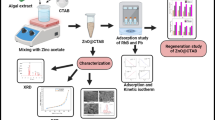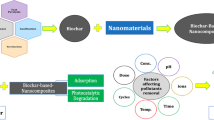Abstract
N-doped carbon fibers (NCFs) were in situ prepared by Camellia sinensis branches waste through hydrothermal carbonization with urea/ZnCl2 at 160–280 °C under 0.8–8.9 MPa. The structural characteristics of NCFs were investigated by elemental analysis, SEM, TEM, XRD, XPS, Raman spectra, and BET surface area. The highest N content of NCFs obtained at 280 °C was 8.96%, and the main forms of doped N were pyridinic N, pyrrolic N, and graphitic N. Moreover, NCFs were applied to remove metal ions successfully. The results showed that NCF-240 had the maximum adsorption amounts of 106.52, 125.23, and 153.49 mg/g for Cu2+, Pb2+, and Zn2+, respectively, while NCF-280 had the best removal ability on Cr6+ (145.67 mg/g). Finally, it demonstrated that the adsorption behavior of NCFs was well fitted by the pseudo-second-order kinetic and the Langmuir adsorption isotherm models.






Similar content being viewed by others
Data availability
Not applicable.
References
Akkaya G, Güzel F (2013) Bioremoval and recovery of Cu(II) and Pb(II) from aqueous solution by a novel biosorbent watermelon (Citrullus lanatus) seed hulls: kinetic study, equilibrium isotherm, SEM and FTIR analysis. Desalin Water Treat 51:7311–7322
Ban SE, Lee EJ, Lim DJ, Kim IS, Lee JW (2022) Evaluation of sulfuric acid-pretreated biomass-derived biochar characteristics and its diazinon adsorption mechanism. Bioresour Technol 348:126828
Chen W, Chen YQ, Yang HP, Xia MW, Li KX, Chen X, Chen HP (2017) Co-pyrolysis of lignocellulosic biomass and microalgae: products characteristics and interaction effect. Bioresour Technol 245:860–868
Dhir B (2014) Potential of biological materials for removing heavy metals from wastewater. Environ Sci Pollut Res 21:1614–1627
Feizi M, Jalali M (2015) Removal of heavy metals from aqueous solutions using sunflower, potato, canola and walnut shell residues. J Taiwan Inst Chem Eng 54:125–136
Gao YF, Wang HT, Guo JH, Peng P, Zhai MZ, She D (2016) Hydrothermal degradation of hemicelluloses from triploid poplar in hot compressed water at 180–340 °C. Polym Degrad Stab 126:179–187
Ghadikolaei NF, Kowsari E, Balou S, Moradi A, Taromi FA (2019) Preparation of porous biomass-derived hydrothermal carbon modified with terminal amino hyperbranched polymer for prominent Cr(VI) removal from water. Bioresour Technol 288:121545
Guo SS, Gao YF, Wang YC, Liu ZJ, Wei XN, Peng P, Xiao B, Yang YJ (2019) Urea/ZnCl2 in situ hydrothermal carbonization of Camellia sinensis waste to prepare N-doped biochar for heavy metal removal. Environ Sci Pollut Res 26:30365–30373
Guo SS, Wang YC, Wei XN, Gao YF, Xiao B, Yang YJ (2020) Structural analysis and heavy metal adsorption of N-doped biochar from hydrothermal carbonization of Camellia sinensis waste. Environ Sci Pollut Res 27:18866–18874
Guo SS, Awasthi MK, Wang YF, Xu P (2021) Current understanding in conversion and application of tea waste biomass: a review. Bioresour Technol 338:125530
Hashem A, Aniagor CO, Nasr MF, Abou-Okeil A (2021) Efficacy of treated sodium alginate and activated carbon fibre for Pb(II) adsorption. Int J Biol Macromol 176:201–216
Hassan MF, Sabri MA, Fazal H, Hafeez A, Shezad N, Hussain M (2020) Recent trends in activated carbon fibers production from various precursors and applications-a comparative review. J Anal Appl Pyrolysis 145:104715
Hou YR, Yan SN, Huang GG, Yang QP, Huang SR, Cai JJ (2020) Fabrication of N-doped carbons from waste bamboo shoot shell with high removal efficiency of organic dyes from water. Bioresour Technol 303:122939
Hu FP, Wang M, Peng XM, Qiu FX, Zhang T, Dai HL, Liu ZM, Cao Z (2018) High-efficient adsorption of phosphates from water by hierarchical CuAl/biomass carbon fiber layered double hydroxide. Colloids Surf A 555:314–323
Huang Z, Xiong C, Zhao MH, Wang SX, Zhou Y, Dai LQ, Zhang LB (2021) Surface-functionalized pomelo peel-derived biochar with mercapto-1,2,4-triazloe for selective elimination of toxic Pb (II) in aqueous solutions. Adv Powder Technol 32:1013–1022
Jia ZG, Li ZY, Ni T, Li SB (2017) Adsorption of low-cost absorption materials based on biomass (Cortaderia selloana flower spikes) for dye removal: kinetics, isotherms and thermodynamic studies. J Mol Liq 229:285–292
Khalil U, Bilal Shakoor M, Ali S, Rizwan M, Nasser Alyemeni M, Wijaya L (2020) Adsorption-reduction performance of tea waste and rice husk biochars for Cr(VI) elimination from wastewater. J Saudi Chemi Soc 24:799–810
Lahijani P, Mohammadi M, Mohamed AR (2018) Metal incorporated biochar as a potential adsorbent for high capacity CO2 capture at ambient condition. J CO2 Util 26:281-293
Lédé J (2012) Cellulose pyrolysis kinetics: an historical review on the existence and role of intermediate active cellulose. J Anal Appl Pyrolysis 94:17–32
Leng LJ, Xu SY, Liu RF, Yu T, Zhuo XM, Leng SQ, Xiong Q, Huang HJ (2020) Nitrogen containing functional groups of biochar: an overview. Bioresour Technol 298:122286
Li J, Ng DHL, Song P, Kong C, Song Y, Yang P (2015) Preparation and characterization of high-surface-area activated carbon fibers from silkworm cocoon waste for Congo red adsorption. Biomass Bioenergy 75:189–200
Li Q, Zhai JP, Zhang WY, Wang MM, Zhou J (2007) Kinetic studies of adsorption of Pb(II), Cr(III) and Cu(II) from aqueous solution by sawdust and modified peanut husk. J Hazard Mater 141:163–167
Liang HX, Zhang HW, Zhao PY, Zhao XK, Sun HW, Geng ZC, She D (2021) Synthesis of a novel three-dimensional porous carbon material and its highly selective Cr(VI) removal in wastewater. J Cleaner Prod 306:127204
Liu C, Ngo HH, Guo WS (2012) Watermelon rind: agro-waste or superior biosorbent? Appl Biochem Biotechnol 167:1699–1715
Ma FQ, Gui YY, Liu P, Xue Y, Song W (2020) Functional fibrous materials-based adsorbents for uranium adsorption and environmental remediation. Chem Eng J 390:124597
Osman AI, Blewitt J, Abu-Dahrieh JK, Farrell C, Al-Muhtaseb AH, Harrison J, Rooney DW (2019) Production and characterisation of activated carbon and carbon nanotubes from potato peel waste and their application in heavy metal removal. Environ Sci Pollut Res 26:37228–37241
Park SJ, Kim YM (2005) Adsorption behaviors of heavy metal ions onto electrochemically oxidized activated carbon fibers. Mater Sci Eng A 391:121–123
Qu J, Zhang Q, Xia YS, Cong Q, Luo CQ (2015) Synthesis of carbon nanospheres using fallen willow leaves and adsorption of rhodamine B and heavy metals by them. Environ Sci Pollut Res 22:1408–1419
Sakhiya AK, Baghel P, Anand A, Vijay VK, Kaushal P (2021) A comparative study of physical and chemical activation of rice straw derived biochar to enhance Zn2+ adsorption. Bioresour Technol Rep 15:100774
Sarma GK, Sen Gupta S, Bhattacharyya KG (2019) Nanomaterials as versatile adsorbents for heavy metal ions in water: a review. Environ Sci Pollut Res 26:6245–6278
Shakya A, Agarwal T (2019) Removal of Cr(VI) from water using pineapple peel derived biochars: adsorption potential and re-usability assessment. J Mol Liq 293:111497
Shinde SD, Meng XZ, Kumar R, Ragauskas AJ (2018) Recent advances in understanding the pseudo-lignin formation in a lignocellulosic biorefinery. Green Chem 20:2192–2205
Srivastava S, Agrawal SB, Mondal MK (2015) A review on progress of heavy metal removal using adsorbents of microbial and plant origin. Environ Sci Pollut Res 22:15386–15415
Sun DZ, Li FY, Jin JW, Khan S, Eltohamy KM, He MM, Liang XQ (2022) Qualitative and quantitative investigation on adsorption mechanisms of Cd(II) on modified biochar derived from co-pyrolysis of straw and sodium phytate. Sci Total Environ 829:154599
Sun QQ, Zhao XK, Wang DM, Dong JE, She D, Peng P (2018) Preparation and characterization of nanocrystalline cellulose/Eucommia ulmoides gum nanocomposite film. Carbohydr Polym 181:825–832
Wan ZQ, Li KQ (2018) Effect of pre-pyrolysis mode on simultaneous introduction of nitrogen/oxygen-containing functional groups into the structure of bagasse-based mesoporous carbon and its influence on Cu(II) adsorption. Chemosphere 194:370–380
Wang WL, Liu Y, Liu XH, Deng BJ, Lu SY, Zhang YR, Bi B, Ren ZM (2018) Equilibrium adsorption study of the adsorptive removal of Cd2+ and Cr6+ using activated carbon. Environ Sci Pollut Res 25:25538–25550
Wu Y, Qiu XD, Cao SY, Chen JJ, Shi XW, Du YM, Deng HB (2019) Adsorption of natural composite sandwich-like nanofibrous mats for heavy metals in aquatic environment. J Colloid Interface Sci 539:533–544
Yu JJ, Chou SY (2000) Contaminated site remedial investigation and feasibility removal of chlorinated volatile organic compounds from groundwater by activated carbon fiber adsorption. Chemosphere 41:371–378
Yu WC, Lian F, Cui GN, Liu ZQ (2018) N-doping effectively enhances the adsorption capacity of biochar for heavy metal ions from aqueous solution. Chemosphere 193:8–16
Yuan JJ, Zhu Y, Wang JZ, Liu ZG, He MY, Zhang T, Li PP, Qiu FX (2021) Facile modification of biochar derived from agricultural straw waste with effective adsorption and removal of phosphorus from domestic sewage. J Inorg Organomet Polym Mater 31:3867–3879
Zhao DZ, Wang Z, Lu S, Shi XM (2020) An amidoxime-functionalized polypropylene fiber: competitive removal of Cu(II), Pb(II) and Zn(II) from wastewater and subsequent sequestration in cement mortar. J Cleaner Prod 274:123049
Zhou Z, Xu ZH, Feng QJ, Yao DH, Yu JG, Wang DS, Lv SQ, Liu YF, Zhou N, Zhong ME (2018) Effect of pyrolysis condition on the adsorption mechanism of lead, cadmium and copper on tobacco stem biochar. J Cleaner Prod 187:996–1005
Acknowledgements
The authors thank the Key Research and Development Program of Shaanxi (2021ZDLNY04-03) and the Agricultural Special Fund Project of Shaanxi Province (NYKJ-2021-YL(XN)20) for supporting this work.
Funding
This work was supported by the Key Research and Development Program of Shaanxi (2021ZDLNY04-03) and the Agricultural Special Fund Project of Shaanxi Province (NYKJ-2021-YL(XN)20).
Author information
Authors and Affiliations
Contributions
Shasha Guo conducted all experimental works, collected and analyzed the data, and wrote the first draft; Yubo Liu assisted the first author in experiments; Weiguo Zhang and Yancheng Wang prepared the material and collect the data; Bin Xiao contributed to the investigation, validation, and proofread the draft; Yuefang Gao conceived the idea, interpreted the data, and proofread the final manuscript. All the authors read and approved the final manuscript.
Corresponding author
Ethics declarations
Ethics approval
This article does not involve any human participants or animals.
Consent to participate
Not applicable.
Consent for publication
Not applicable.
Competing interests
The authors declare no competing interests.
Additional information
Responsible Editor: Zhihong Xu
Publisher’s note
Springer Nature remains neutral with regard to jurisdictional claims in published maps and institutional affiliations.
Supplementary information
ESM 1
(DOCX 458 kb)
Rights and permissions
About this article
Cite this article
Guo, S., Liu, Y., Zhang, W. et al. N-doped carbon fibers in situ prepared by hydrothermal carbonization of Camellia sinensis branches waste for efficient removal of heavy metal ions. Environ Sci Pollut Res 29, 88951–88961 (2022). https://doi.org/10.1007/s11356-022-21923-2
Received:
Accepted:
Published:
Issue Date:
DOI: https://doi.org/10.1007/s11356-022-21923-2




